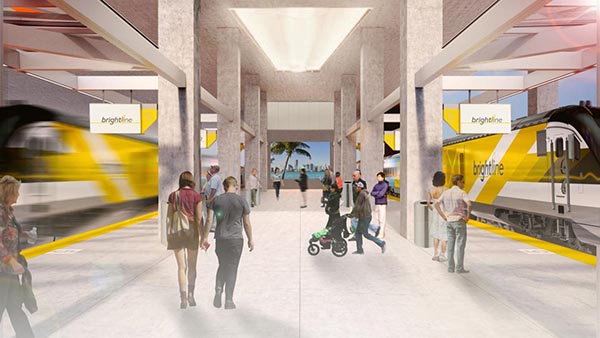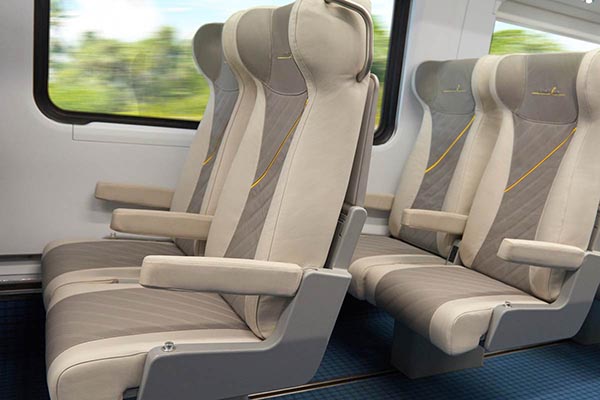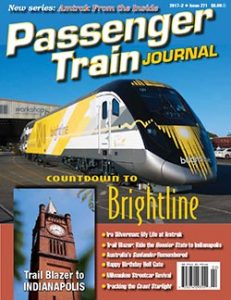By Kent Patterson/photos courtesy Brightline
Brightline. The name exudes excitement, modernity, and color. Hard to believe that it refers to a U.S. rail operation—a passenger rail operation no less. In fact, Brightline— Florida’s now-abuilding Miami–West Palm Beach–Orlando higher-speed passenger service— stands to be a rainbow of hope in a country fraught with endless waffling on commitment to a solid passenger-rail system like the rest of the world.
Brightline is well on its way to proving that a private intercity rail passenger venture just may work and even be profitable. What gives wonder to it all is that Brightline arose—initially as All Aboard Florida—from the DNA of a railroad, Florida East Coast, whose roots date from the late 1800s and was a premier passenger carrier into the latter half of the 20th Century.
Why has a U.S. freight railroad become interested once again in the passenger business? Actually, it’s not FEC itself that’s reawakening; rather it’s its parent, Florida East Coast Industries (FECI), Florida’s largest commercial realestate, transportation, and infrastructure holding company.
Longtime Florida-based real-estate empire, FECI holds many real-estate assets in downtown Miami, Fort Lauderdale, and a lesser but growing Palm Beach portfolio. Visonary FECI sees southeast Florida’s Gold Coast cities as a region still harboring much growth potential. Fostering this newish megalopolis north from Miami requires a strong regional infrastructure.
Regarding infrastructure, Mr. Henry Flagler’s 350-mile FEC rail property bears significant importance in that Brightline will be using FEC rails as a key travel artery through the region. Passenger trains as a business that went dormant in the 1960s suddenly got dusted off in 2012 when FECI executives concluded that a solid, first-class regional passenger railroad was needed between South Florida and Central Florida. And, it needed to be something frequent and fast, much like the New York–Philadelphia– Washington Corridor.

Brightline’s genesis began in 2012 under the guise of All Aboard Florida, a then-new subsidiary of FECI. The name Brightline is actually a branding of a specific service that will be offered by AAF. The speed and momentum of this project is perhaps its most impressive aspect. Rail industry backers, stakeholders, rail enthusiasts, and professionals haven’t seen such a fast moving rail-build in their lifetime.
As observers of the rail industry, we are more accustomed to ideas, studies, proposals, pipe dreams, and PowerPoint presentations, and if a project actually begins, it’s a long road to fruition—if they’re not stalled altogether. Here in Southeast Florida, Brightline moves at a tempo reminiscent of the Seaboard Air Line Railroad racing to Miami in the 1920s, or perhaps a reminder of the race to complete the first transcontinental railroad.
Track
Part of the speed is owed to the Florida East Coast simply exercising use of its right-of-way. FEC had a top-notch two-track Jacksonville– Miami main line with ATC (Automatic Train Control, an ancestor of today’s PTC or Positive Train Control), fast freights, and streamliners from the north. Speeds were up to 90 m.p.h. for passenger trains. A decline in infrastructure through the 1950s, a bitter 1963 strike, and loss of passenger service led to some of FEC’s retrenchment in the 1960s.
Largely, FEC single-tracked its magnificent arrow-straight double-track main line. However, in doing so, FEC kept good speed and service standards, had well-spaced long passing sidings, and dual-directional signals, becoming known for its plentiful, short fast freights and piggyback trains without cabooses—unheard of then. A voluminous commodity, limestone, then and today moves on this right-of-way at 60 m.p.h., a freight speed virtually unheard in the East. Granite ballast, concrete ties, and 136-pound rail support a track that could readily accept passenger equipment (FEC circa 1995 considered accepting the handling of one of Amtrak’s New York–Miami trains).
The new Siemens equipment that will serve in Brightline service is lighter, plus it can accelerate fast—a key in keeping a schedule. Brightline’s re-double tracking of FEC’s southern portion addresses the added daily passenger train volume to its current roughly dozen and a half freight trains daily.
The 1960s-era interlockings, still in good shape, are being replaced with universal high-speed crossover interlockings spaced about 15 miles apart. Rail-grade crossings are numerous, and have much to do with the 79-m.p.h. speed limit over track that is good for over 100 m.p.h. Many crossings also got upgrades over the last two years. Both tracks have reversible signaling, with Positive Train Control as part of the facelift FEC is getting up to Cocoa Beach. By and large, Brightline’s speed in development is owed to many—project managers and workers; FEC managers and workers, plus good purchases and effective project management.

Motive power comprises end pairs of Siemens Charger locomotives, each with 4,400 horsepower, about double that of a 1950s E8 diesel. Its prime mover is the Cummins QSK95, 16-cylinder, low-emission, Tier-4-compliant diesel. A new low-key emission aspect is made possible by spraying diesel emissions fluid into the exhaust after-treatment to transform the NOx into nitrogen gas and water. Chargers also house a large clean, well-lit, quiet, dust-free electronic climate-controlled room to protect much of its weather-sensitive hardware. These newest passenger locomotives, nearly a hundred ordered as a group order earmarked to Amtrak state-supported corridors in Illinois, Missouri, Minnesota, California, Maryland, Washington, and Michigan, with added possibilities under study—such as perhaps a dual-mode or long-distance version. Brightline has purchased ten with options for 11 more. As of this writing, two sets are now outshopped from Siemens.
Unlike the carbon-steel-painted locomotives, Brightline’s coaches are instead decaled, thanks to a stainless-steel carbody. The entire train is ADA compliant; that includes 32-inch aisles and automatic gap-fillers, eliminating gaps between the car and the boarding platform at all passenger entrances. Crumple-designed car portions, such as draw-bars (no-couplers), will enhance the already-in-place respected U.S. buffer and safety standards. Although the initial phase of service between West Palm Beach and Miami will not have the café cars, there will be beverage and snack service. The cafés will arrive in concert with the Orlando start-up phase. The 240-seat equipment sets will have a “Select Class” car with 50 seats featuring 2-1 seating; and Smart Class coaches will have 66 seats.
Initial service shortly
Brightline will start this year as a higher-speed commuter operation of sorts, linking three downtown hubs—Miami, West Palm Beach, and Fort Lauderdale—where the combined population totals over 8 million. Much of this population is immersed in new construction that will be in close proximity to each station, and the housing in those areas will include some 25,000 apartments and condos that will be within walking distance. Those central areas will have extensive entertainment, dining, and shopping venues too. Although some area residents may not wish to live near the railroad, these are concept-station areas already attracting residential interest by those who see the value of this enhanced mobility.
Brightline is now advertising the running times from its “Miami Central” terminal: Ft. Lauderdale in 30 minutes, West Palm Beach in an hour. Anyone familiar with travelling between those three central business districts will attest that current travel times on other modes take much longer and often have onerous journeys.
Transit connectivity will also be key to passenger use. Miami will have the most extensive network. Tri-Rail commuter trains, which use former CSX (ex-Seaboard Air Line/Seaboard Coast Line) tracks from the Miami Airport to West Palm Beach will also connect into Brightline’s MiamiCentral terminal using FEC tracks. Miami-Dade’s Metrorail, and downtown Metro- Mover loop will also serve this hub.



